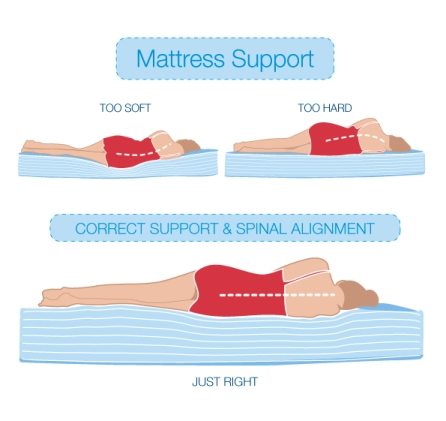5 tips for finding a better nights sleep for people with back pain.
Small changes to your sleeping positions or sleeping environment can make a huge impact on your back pain.
In many cases we will see people after sleeping in poor postures such as on planes, wrong mattresses and or the park bench! The best position for your lower back is to sleep on your sides or on your back. It is best to avoid stomach sleeping.
The night-time can seem to go on for an eternity when your in pain.
-
Don’t go too soft
With regards to the best mattress material it can be like Goldilocks and the three bears- too soft, too hard and just right. But how do you find the just right! In many cases sales people will sell you a soft mattress as these usually feel the best in store, for short periods of rest. But over extended periods mattresses that are too soft aren’t kind to spines. We recommend a medium to firm mattress with a small pillow top. A too firm mattress can lead to hip issues like a hip bursitis or aggravation of lower back pain. Too softer mattress in many cases will lad to chest wall and thoracic pain. And getting it just right = zzzzzzzzzz’s ( a great night sleep). A quick tst is that when you are lying on your side your spine should be aligned. So the middle of your buttock or hips should line up with your lower back, mid back and your neck. When lying on your back your lower back should be supported and you shouldnt have a hollow under your lower back. Another indication of incorrect mattress density is that you need to cross your legs when you lay in bed- this often indicates that you are on a too firm mattress. When buying a new mattress never pay full price- in most cases you can save 50% by some smart negotiation.

image- http://sleepdelivered.com/
2. Use more than one pillow
If you are in pain use more than one pillow! But not under your head!. Use a pillow under your knees if your lying on your back or between your knees if your on your side. We can help you with great little sleeping pillows that aren’t as cumbersome and stay in place- but try normal pillows first.
3. Stretch before and after sleeping
Any posture whether it be sitting, bending or sleeping is a sustained position. Sustained postures can put strain on the muscles, ligaments and joints in your body. One of the most common pieces of advice we give people is to stretch before going off to bed/sleep and on waking- before you even get out of bed. This helps negate the effects of a sustained sleeping posture. It is easy and takes 30-60 seconds. If you want a suitable stretching program email us on
A quick sign that stretching is crucial is if you get sharp pain when you first lay on your back in bed. This feeling often is as though the back doesn’t want to relax onto your mattress. In many cases this will be because you have sat or been in a flexed position for too much or too long during the day. Stretch your back out and see if the pain eases or disappears. In many, if not most cases this will assist on making the symptoms disappear. Stretching then is sometimes something you may need to continue to do on a daily basis to be your best.
4. Think about your pillow/bed relationship and change your pillow regularly
People often find that selecting the right pillow is as hard or even harder than finding the right bed. We will show you in our next episode how to find the right pillow. However, pillows need to be matched to your mattress to get the right combination. The same pillow will behaviour very differently on different density beds/mattresses. So when you are shopping for a new bed take your pillow along. Pillows and any foam will also detrior
5. Relax before relaxing
Muscles can often be overactive when you are in pain. It could be related to your underlying condition or your daily activities. Stretching as mentioned above with help but relaxation or meditation can drastically improve your sleep quality and in many cases reduce your waking pain. We recommend a couple of app based relaxation tools- probably the best is
Its free and we challenge you to trying it for 14 days and see if you sleep better. We wont even say “I told you so.
If you are able to get a better nights sleep then your pain will reduce. If your pain reduces you will get a better nights sleep. So be proactive with these tips.
